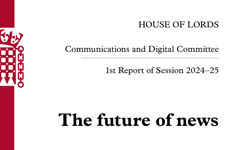Norway’s eZ Systems is big. It’s big in Europe, it’s big in the US, but, so far, it’s not yet that big in the UK. The Norwegian company hopes that is about to change and have appointed ex BPA London director Stuart Wilkinson to set up a UK operation, and he will be recruiting a country manager and local developers over the next twelve months.
The eZ content management system has over a thousand enterprise level publishing clients spread across 120 countries and a community of 40 thousand members, and it is this open source dimension to the software that helps keep it cutting edge. The vibrant developer community is constantly developing the core product in response to changing publisher needs and technologies and those enhancements are then fully road tested by eZ software engineers every six months and then fed into a new release of the enterprise level software.
You can start using the community level version of the software for free, but if your site is business-critical, then they recommend you take the fully road tested enterprise version, and that’s … err … not free.
The eZ system is a content management platform upon which their publishing clients (like Hachette in Europe and Christian Science Monitor in the US) and appointed commercial partners build websites.
In fact, I’d better stop referring to their product as a CMS system, because that acronym, according to Stuart, is dated. More relevant ones include WCM (web content management), or CXM (customer experience management) or OCO (online channel optimisation)!
Stuart said that modern CMS/WCM/CXM/OCO systems were about more than simply holding content; key to their success were the layers of functionality to make the content work harder for the benefit of users and advertisers. A few years ago, elaborated eZ’s Bertrand Maugain; the focus of such systems was on sharing and publishing content, now the focus is on how to optimise the user experience, empower the content and fully exploit all the commercial possibilities presented during the visitor’s time on your site.
‘Web first’ might be the mantra, but print is very much part of the mix. The eZ platform interfaces with InDesign and print is simply another output, all managed on the same system.
Earlier in the week, version 4.6 of eZ Publish (also known as Annapurna, after eZ’s habit of naming all their major releases after famous mountains; in the pipeline are Etna and Kilimanjaro. I wonder if they’ve had a Snowdon.) Of particular note, said Bertrand, in the Annapurna release were two modules, Yoochoose, which, by tracking user behaviour and matching that to the content itself, was able to provide the user with personalised recommendations (eg “people like you were also interested in …”) and he referred to some recent AB testing done by one publisher that showed that such a recommendation resulted in 51% more clicks.
The second module he highlighted was Odoscope that allowed site owners to track the user journey in great detail and to then use the data to focus resources on areas of concern or opportunity on the site. For instance, if the system showed that 80% of visitors using an iPhone left the site at such and such a page, then speedy corrective action can be taken. Knowledge is king.
Two of eZ partners were then given the floor.
Tony Wood of Vision with Technology, a company that describes itself as “Experts in eZ Publish Consultancy and Development” has been an eZ partner in the UK since 2002 and had built many websites using the platform, including for FT Business.
What he particularly liked about it was the choice it gave you. “I like choice; I hate having to do something.” In his nine years using the system, he had never found something the system couldn’t do, and the constant community lead development kept the system ahead of the curve.
Tony spoke about paywall strategies. He had identified five, and, he was pleased to say, eZ Publish could handle them all, either individually or hybrid.
His five paywall strategies were:
1. Tease paywall.
Sites like the Sunday Times that showed you a single screen containing links to various content, but which then put up a payment or registration barrier as soon as you clicked on them. The registration might be for a free trial.
2. Glass paywall.
A shop window approach, where various pages (selected by either the editor, system or taxonomy) were presented for free to whet the visitor’s appetite, with the rest of the content being subscription based.
3. Metered paywall.
The FT.com way. Metering could be based on the number of pages, an amount of time or even ads watched.
4. Time paywall.
This approach charges for the newest, shiniest content, but sells older content at a reduced rate or even gives it away for free. The iTunes charts were an example of this, said Tony, where the newest films attracted top dollar, but as time elapsed, so the price went down. Stocks and shares sites could operate something similar, with access to the current hot news and tips charged for.
5. B2B site license.
The entire site is locked down and you buy a license; an increasingly popular approach for B2B publishers.
Of course all these models rely on an efficient and real-time interface with the subscriber database to control access. Iain Adams of subscription management specialists CIRCDATA was on hand to extol the virtues of the single customer view (SCV). By drawing together all the various interactions between a customer and your brands (print subscriptions, online subs, mobile, email newsletters, SMS and event registrations) you could gain the fullest possible picture of your customers. The SCV gives you invaluable insight into buying habits, allows you to cross- and up-sell and exercise more intelligent control over your marketing communications.
CIRCDATA have just become a new eZ partner and recently built a website, using the eZ platform, for a client in two days, down from the more usual 20 days. As an eZ partner, they will now be able to build content websites, and interface them directly with their Fusion database to provide publishers with a full 360 degree view of their customers.
Exciting times!










